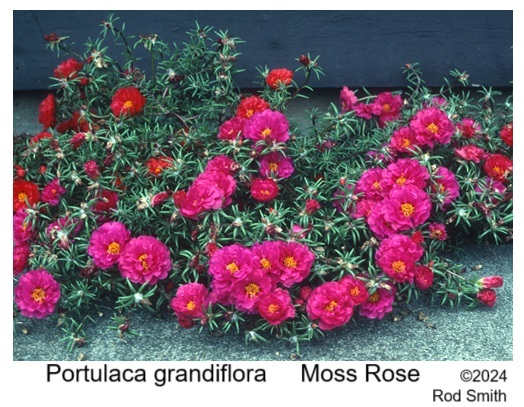 Some annuals are self sowing which means that they come back by seed naturally every year. Cosmos and Moss Rose are common examples.
Some annuals are self sowing which means that they come back by seed naturally every year. Cosmos and Moss Rose are common examples.
Most garden flowers are either annuals or perennials. Annuals complete their life cycle in one year. They sprout from seeds, grow until they flower and produce seeds, then die in the fall. A good way to remember is that annuals are planted annually.
 Some annuals are self sowing which means that they come back by seed naturally every year. Cosmos and Moss Rose are common examples.
Some annuals are self sowing which means that they come back by seed naturally every year. Cosmos and Moss Rose are common examples.
Biennials are like annuals except that it takes two years to complete their life cycle. They grow leaves the first year, then flowers and seeds the second year before they die. Sweet William and wild foxgloves are common examples although some cultivated foxgloves flower the first year.
Perennials live for many years but do not have woody stems like trees and shrubs have. Some are grown from seeds while others are only available as started plants. A good way to remember is that perennials are permanent.
Tender perennials do not survive much freezing. They are often grown as annuals although they would live for many years if they are moved to a place protected from freezing. Begonias, fuchsias, geraniums and impatiens are common examples. Some perennials live only a few years, but many perennials will outlive the gardener who plants them.
Bulbs are a special class of perennials which survive the winter as a specialized plant part. This makes them easy to transplant. True bulbs are mostly leaves with a short stem.
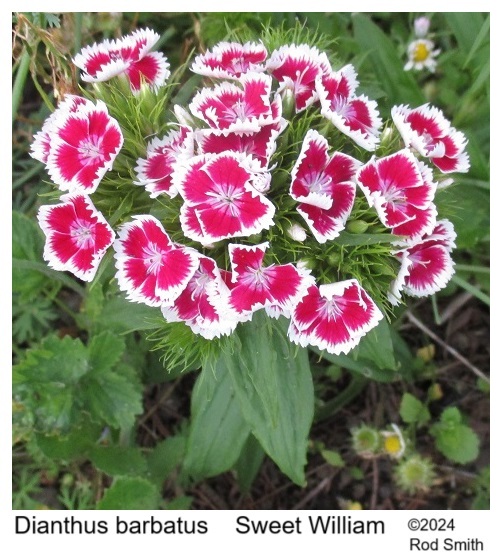 Daffodils, hyacinths, lilies and tulips are common examples. Corms are mostly stem. Gladiolus is a common example. Tubers are special underground stems. Begonia and ranunculus are common examples. Tuberous roots are swollen roots. Dahlia is a common example. Rhizomes are special stems which grow horizontally just below the surface. Iris is a common example.
Daffodils, hyacinths, lilies and tulips are common examples. Corms are mostly stem. Gladiolus is a common example. Tubers are special underground stems. Begonia and ranunculus are common examples. Tuberous roots are swollen roots. Dahlia is a common example. Rhizomes are special stems which grow horizontally just below the surface. Iris is a common example.
Annuals and perennials each have their advantages and disadvantages. Annuals start with a clean slate every year. Diseases and some weeds are easier to control. Different flower types and color combinations can easily be planted each year. Annual seeds are usually less expensive. Once they start blooming, they usually continue to bloom until a killing frost. Since they have a short life cycle, new plant types and flower colors can be developed quicker. Many annuals come in series, such as Elfin Impatiens and Madness Petunias. The different varieties in a series have the same size and shape, but the flower colors are different. This allows a garden to repeat uniform looking plants while having multi-colored flowers. Disadvantages are that annuals have to be replanted each year. Also, they normally do not start blooming until summer.
Perennials live for many years. Many can be divided and shared with family, friends and neighbors. Some bloom in the winter or spring before annuals start blooming. Some bloom later into the fall than annuals. Some perennials will grow with less sun or less water than any annual. Some perennials are evergreen so at least there are green leaves all winter. Some spread thickly to form a groundcover, which helps prevent weeds from growing. Disadvantages are that perennials take time to spread and cover a planting bed. Not as many flower colors are available. Perennial weeds are harder to control.
The time and labor required for annuals is more than for perennials, but the timing is different. Most of the labor for annuals is in the spring
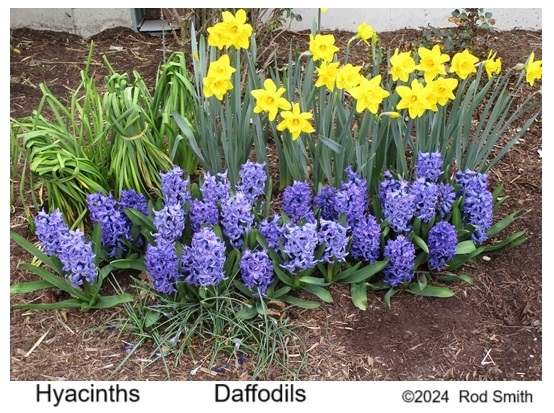 during the planting season when gardeners are eager to garden. Labor for perennials is spread out more during the growing season, but more is required in the fall to clean
up the plants and prepare them for winter.
during the planting season when gardeners are eager to garden. Labor for perennials is spread out more during the growing season, but more is required in the fall to clean
up the plants and prepare them for winter.
Annuals and perennials work well together in the same bed. Perennials can form the permanent structure of the bed and provide color during the fall, winter and spring as well as summer. Annuals can be used to fill in the spaces between the perennials until they grow to full size. Annuals can also add splashes of color and change with changing color fashions.
Flower beds require more work than trees and shrubs, but they also provide more interest. Therefore, they should be placed in highly visible parts of the landscape. Next to the sidewalk or front door are prominent locations in the front yard, or next to a patio or deck in the back yard. Another prominent location is right outside a window so it is highly visible from inside. This is an especially good spot for winter and spring blooming perennials so they can be enjoyed regardless of the weather. It is also a good spot for highly fragrant plants if the window can be opened to let in the fragrance.
The
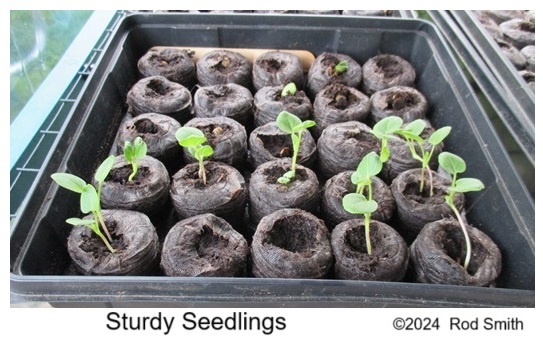 amount of sunlight needs to be considered. A few annuals and perennials will grow in sun or shade, but most require the right amount of sunlight. Also, a bed next to a south or
west facing wall will be brighter and hotter because of reflected light and heat. A bed sloping up on the north or east side of a sidewalk or driveway also gets some reflected light and heat.
amount of sunlight needs to be considered. A few annuals and perennials will grow in sun or shade, but most require the right amount of sunlight. Also, a bed next to a south or
west facing wall will be brighter and hotter because of reflected light and heat. A bed sloping up on the north or east side of a sidewalk or driveway also gets some reflected light and heat.
The principles for landscape design also apply to flower beds, except on a smaller scale. Usually the entire flower bed is visible at once so it should be designed as a fixed viewpoint with small plants in front and tall plants in back.
Some of the taller perennials can be blown over by winds, so it is helpful to plant them next to a wooden fence or wall. Some flower beds are observed from all sides, so the tallest plants should be in the center, and low plants on the edges. Flower color and blooming
season are especially important so plants blooming at the same time do not have clashing colors. Usually the flower bed is small enough that all plants should
tolerate the same soil moisture and pH. See the Perennials webpage for information on the height, blooming
season, sunlight and water needs of perennials.

Annuals and perennials from seed are planted in the spring. The seeds can be started indoors about six weeks before planting outdoors for earlier flowers and a longer growing season. Annual and perennial plants can be planted any time of year if the soil can be worked and plants are available. Many perennials can be purchased and planted in the fall at clearance prices from local garden centers, but they will need extra protection the first winter until their roots grow deeper.
Most bulbs are planted in the fall. The spring flowering bulbs, such as crocus, daffodils, hyacinths and tulips need to be planted in the fall because they need winter temperatures before they flower. Some nurseries have potted bulb plants available in the spring, but the cost is more. There are also summer flowering bulbs such as begonia, caladium, canna and gladiolus, which are planted in the spring and early summer.
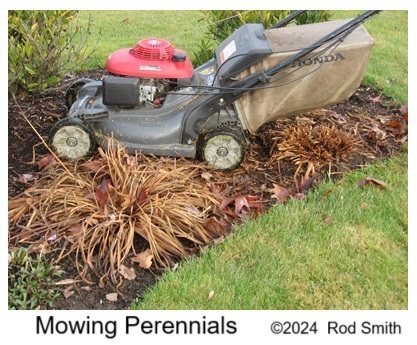 need a fall cleanup and mulching. Dead flower stems and leaves should be removed. Mulching will help prevent winter damage from freezing and frost heaving. Both can be accomplished
quickly and easily by setting a mulching mower at the highest setting and mowing over the perennials. However, if there are many diseased leaves, it is better to bag the clippings and use compost or bark dust for mulch.
need a fall cleanup and mulching. Dead flower stems and leaves should be removed. Mulching will help prevent winter damage from freezing and frost heaving. Both can be accomplished
quickly and easily by setting a mulching mower at the highest setting and mowing over the perennials. However, if there are many diseased leaves, it is better to bag the clippings and use compost or bark dust for mulch.
Many tender perennials can be kept alive over winter, and grown another year. Tender bulbs such as begonias, caladiums, dahlias and gladioli can be stored in open flats on a thin layer of vermiculite or peat moss. Tender perennials, such as fuchsias, geraniums, and New Guinea impatiens, can be overwintered by digging them up and storing them in a shed or unheated garage. Most tender perennials are easier to overwinter in pots, although some gardeners leave their geraniums bare root and hang them upside down in a damp basement. Pots should not be watered so the soil is fairly dry before they are stored. Then, cut stems back to a few inches tall or to the inside edge of hanging baskets. Check the stored plants every month. If there is mold on the soil, peel it off. If the soil is very dry or the plants are shriveling, give them a little water. If the plants have put out new growth, break it off and look for a cooler place to store them. The trick is to keep them between freezing and 40 degrees so they do not freeze or grow. Also they should be kept barely moist so they do not shrivel or mold.
Perennials by Flower Season and Height
Perennials in Alphabetical Order
Oregon Native Landscape Plants